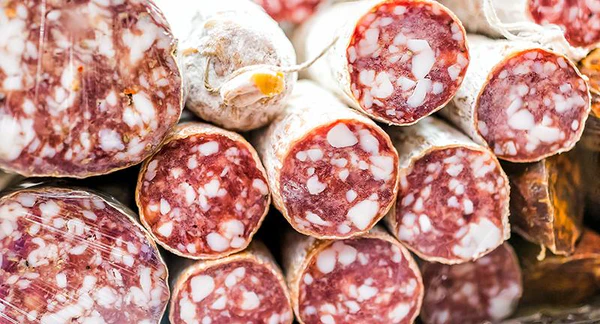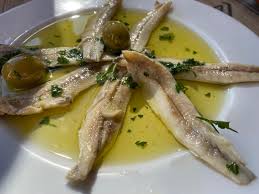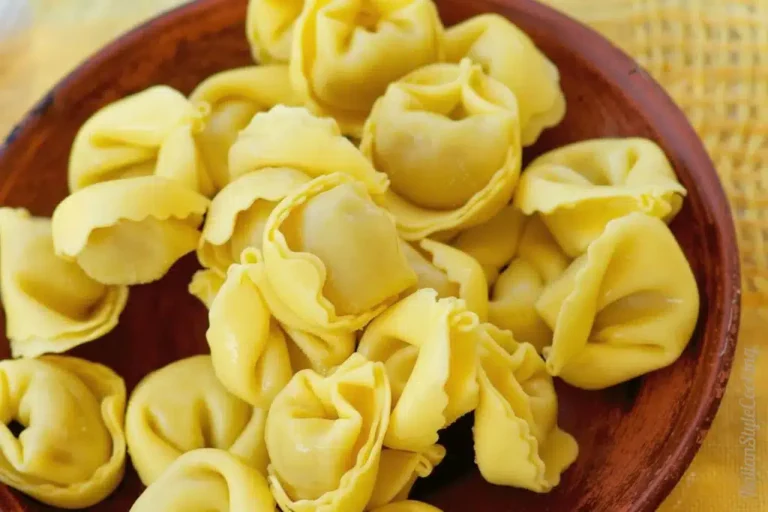
If you’ve ever wandered through an Italian marketplace, chances are you’ve come across Soppressata, a delicious and traditional Italian salami that has become increasingly popular worldwide. Known for its rich, savory flavor and rustic texture, Soppressata is much more than just a type of Italian salami—it’s a cultural staple in many regions of Italy. This guide will walk you through everything you need to know about Soppressata—from its origins and how it’s made to how to enjoy it on your next meal.
Soppressata is an iconic Italian cured meat that hails from the southern regions of Italy, specifically Calabria, but it’s also produced in other regions such as Tuscany and Sicily. It’s a type of dry-cured sausage made primarily from pork and seasoned with a mix of garlic, black pepper, and other spices. Its distinctive coarse texture and rich, savory flavor make it stand out from other types of salami.
This artisan salami is an excellent representation of Italy’s love for charcuterie, a culinary tradition that involves the art of preserving and preparing meat. Soppressata is part of a larger family of Italian cured meats that includes prosciutto, bresaola, and salami. While Soppressata shares characteristics with other salamis, it is unique in its texture, spiciness, and aging process.
What is Soppressata?
At its core, Soppressata is a type of dry-cured sausage that typically consists of a mixture of finely chopped pork, fat, and seasonings, which are then packed into a casing and left to age. The word “Soppressata” comes from the Italian verb soppressare, which means “to press,” referencing the traditional method of pressing the sausage to remove excess air. This method gives Soppressata its characteristic dense texture and deep flavors.
Unlike smoother, finely ground salamis, Soppressata features a coarser, chunkier texture. It is made with larger cuts of meat, giving it a rustic and hearty feel. The seasonings typically include garlic, black pepper, and chili flakes (for a spicier version), which give it a balance of heat and richness. As a dry-cured sausage, Soppressata undergoes a long curing process, allowing it to develop a deeper flavor over time.
In addition to its texture, Soppressata stands out due to the varied regional styles that influence its flavor. For example, Soppressata di Calabria is known for its spicy kick, while Soppressata di Parma is typically milder and more delicate. This diversity makes Soppressata not just a food but a part of Italy’s diverse culinary heritage.
How is Soppressata Made? A Step-by-Step Guide
Making Soppressata is a time-honored tradition that involves a meticulous process of preparation, seasoning, stuffing, and curing. Here’s a step-by-step guide to how Soppressata is made:
- Selecting the Meat: The first step in making Soppressata is selecting high-quality pork. Pork shoulder is the most commonly used cut, as it provides a good balance of lean meat and fat. Some versions also include beef, though pork is the traditional choice.
- Grinding and Seasoning: The pork is chopped or ground into coarse pieces (larger than the finely ground texture of traditional salami). The meat is then mixed with a combination of spices—typically garlic, black pepper, and salt. For a spicier version, chili flakes are added to give it that signature heat.
- Stuffing the Casing: The seasoned meat is then stuffed into natural casings, typically hog or beef intestines, though synthetic casings can be used in some cases. The casing is tightly packed to avoid air pockets that could cause spoilage.
- Pressing the Sausage: Once the casing is filled, the sausage is gently pressed to remove any remaining air, allowing the meat to settle evenly. This pressing process is essential for the characteristic texture of Soppressata.
- Curing: After pressing, the sausage is hung in a cool, dry environment to cure. The curing process can take anywhere from a few weeks to several months, depending on the type of Soppressata being produced. The sausage is monitored carefully for humidity and temperature, as these factors influence the final texture and flavor.
- Aging: As the Soppressata cures, the flavors deepen and the texture becomes firmer. The aging process is crucial in allowing the spices to infuse the meat and develop that distinct, robust flavor.
This detailed process results in a dry-cured sausage that is full of flavor, with a hearty texture and a balance of savory, spicy, and sometimes sweet notes depending on the regional recipe.
Types of Soppressata: What Makes Them Different?
Soppressata comes in several varieties, each influenced by the region it’s produced in. The key differences between them lie in the seasoning, fat content, and spice level. Here are a few of the most notable types:
- Soppressata di Calabria: Known for its spicy salami flavor, Soppressata di Calabria is made with a generous amount of chili flakes, giving it a distinct heat. It’s often a favorite for those who enjoy spicy salami and want a kick in their meat.
- Soppressata di Parma: This version is much milder and focuses more on the natural flavors of the pork. The seasoning tends to be subtler, with fewer chili flakes and a greater emphasis on garlic and pepper. Soppressata di Parma is a great choice if you’re looking for a sweeter, less intense flavor.
- Soppressata Dolce: Often called “sweet Soppressata,” this version is made without chili flakes and has a balanced, savory taste. It’s perfect for those who prefer a mild, non-spicy cured sausage.
- Soppressata Piccante: For those who love intense heat, Soppressata Piccante is the way to go. It’s made with more chili flakes or hot peppers, making it much spicier than other types. This version is often enjoyed with aged cheeses and bold wines.
Each of these types of Soppressata offers a unique tasting experience, and the best version for you depends on your personal taste preference. Whether you enjoy mild or spicy salami, there’s a Soppressata variety for everyone.
The Flavor of Soppressata: What Does It Taste Like?
The flavor of Soppressata is what makes it so beloved. It’s a dry-cured sausage with a complex, bold flavor profile that varies depending on the spices used and the aging process. Here’s what you can expect when you take a bite:
- Savory: The combination of garlic, black pepper, and other seasonings provides a rich, savory depth that is the hallmark of Soppressata.
- Spicy: If you’ve chosen a spicier version, such as Soppressata di Calabria, the chili flakes add a pleasant heat that complements the other flavors.
The result is a savory, flavorful Italian salami that can be enjoyed on its own, paired with cheeses and wine, or used to enhance various dishes.
How to Serve and Pair Soppressata
There are many ways to enjoy Soppressata, and part of the fun is discovering how it pairs with other foods. Here are some popular serving suggestions:
- Charcuterie Board: Soppressata is a perfect addition to a charcuterie platter, where it can be paired with various cheeses (like Parmesan or Pecorino), fruits, olives, and other Italian cured meats.
- Sandwiches and Panini: Slice Soppressata thinly and layer it in a sandwich or panini with fresh vegetables, cheeses, and a drizzle of olive oil.
- With Wine: Pairing Soppressata with wine is an art. A robust red wine like Chianti, Sangiovese, or Barbera complements the richness of the sausage. For a spicier Soppressata, try a wine with a bit of acidity to balance the heat.
How to Store Soppressata and Keep It Fresh
Proper storage is essential for preserving the flavor and quality of Soppressata. Here’s how to keep your dry-cured sausage fresh:
- Whole Soppressata: If you have a whole Soppressata, store it in a cool, dry place, like a pantry or cellar. The casing will protect it during storage.
- Sliced Soppressata: Once sliced, Soppressata should be kept in an airtight container in the refrigerator. It’s best to consume it within 2-3 weeks of opening for the best flavor.
- Freezing: If you have extra Soppressata that you can’t finish, it can be frozen, although this may affect its texture slightly.
Conclusion
In conclusion, Soppressata is a flavorful and versatile Italian salami that offers a unique culinary experience. Whether you prefer the spicy kick of Soppressata di Calabria or the milder Soppressata Dolce, this dry-cured sausage is perfect for charcuterie boards, sandwiches, and more. Its rich, savory taste and traditional production methods make it a must-try for anyone seeking to explore the authentic flavors of Italian cured meats.
FAQs
Is Soppressata spicy?
Some types of Soppressata, such as Soppressata di Calabria, are quite spicy due to the inclusion of chili flakes. However, there are milder varieties like Soppressata Dolce that are not spicy at all.
Can I make Soppressata at home?
Yes, making Soppressata at home is possible, though it requires the right equipment and knowledge of curing meat. It’s a time-consuming process, but there are many recipes available for those who want to try their hand at making their own Italian salami.
How should I serve Soppressata?
Soppressata can be enjoyed on a charcuterie board, in sandwiches, or paired with cheese and wine. It’s also great as a topping for pizza or in pasta dishes.
How long does Soppressata last?
Whole Soppressata can last for several months if stored properly in a cool, dry place. Once sliced, it should be consumed within 2-3 weeks for the best flavor.
Where can I buy authentic Soppressata?
Authentic Soppressata can be found at Italian delis, specialty grocery stores, or online from artisanal producers. Always check for high-quality ingredients like garlic, black pepper, and chili flakes.






